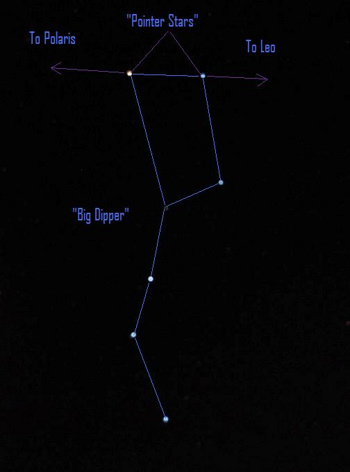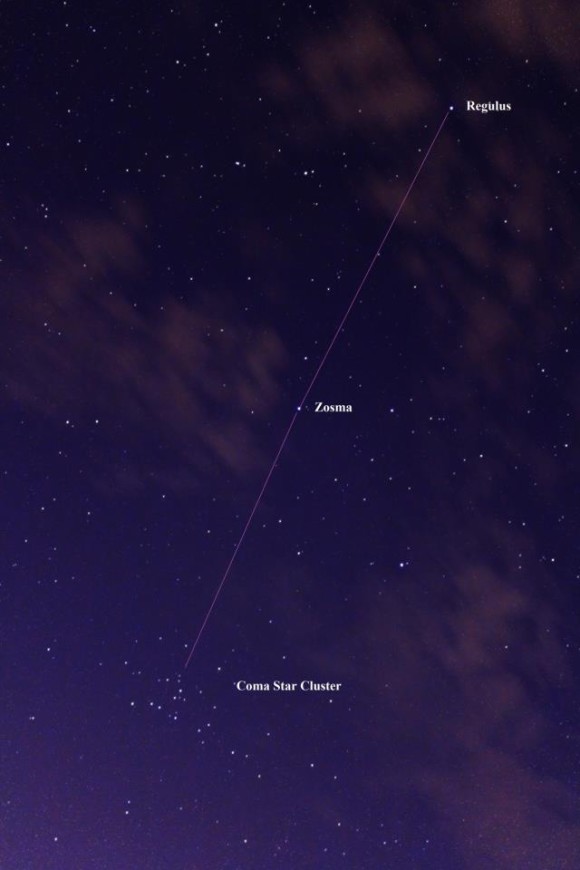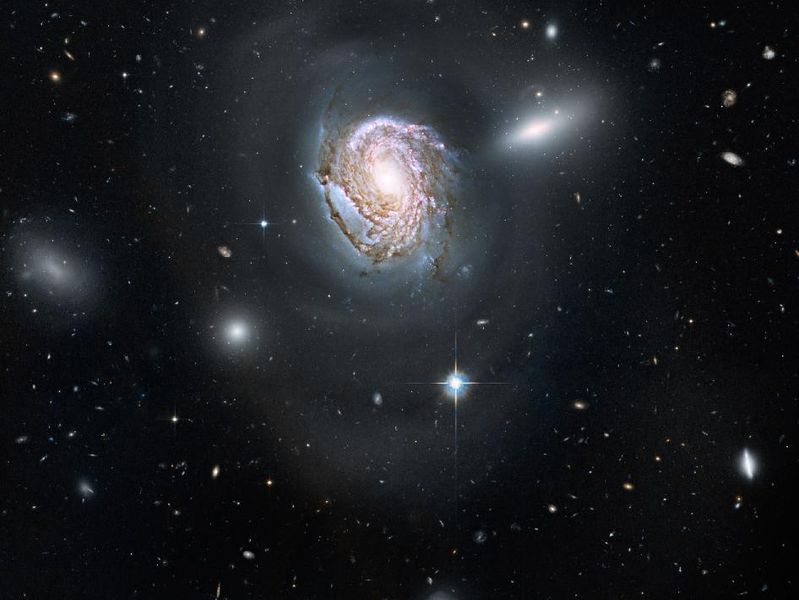
Yesterday we talked about Coma Berenices, which you can see on April evenings. Its stars went from being part of Leo the Lion to being one of the 88 official constellations. Leo’s stars are relatively bright, but the best part of Coma Berenices requires a dark sky to be seen. It’s the beautiful Coma star cluster aka Melotte 111 or Collinder 256. This star cluster is what gives Coma Berenices its feathery (or hairlike) look.
To find Coma Berenices and the Coma star cluster, first find Leo, on the right in the star chart above. Leo’s brightest star – the sparkling blue-white gem Regulus – marks the bottom of an easy-to-see backward question mark of stars known (called The Sickle). A triangle of stars highlights the Lion’s hindquarters and tail. A line drawn from Regulus to one of the stars in the triangle will take you to the Coma star cluster.
Leo? Here’s your constellation

How can you find Leo? A line between the two outer stars in the Bowl of the Big Dipper always points in one direction toward Polaris, the North Star, and in the opposite direction toward Leo.
Look back at the chart at the top of this post, or at the photo below from Zhean Peter Nacionales. You’ll see you can draw a line from the star Regulus through the top star of the triangle (Zosma), and go about twice this distance to locate the cluster.
If you have a truly dark country sky, the Coma star cluster won’t be hard to find, using just your eyes. It’ll be noticeable as many faint stars clustered in a group, looking almost wispy. If your skies are beset by light pollution, you might need binoculars to see this loose tangle of stars. The Coma star cluster is an open star cluster, a relatively young cluster, whose stars were born together and still move together through space. There are about 100 stars in this cluster, which lies some 288 light-years distant.

EarthSky Facebook friend Zhean Peter Nacionales in the Philippines captured this view of the Coma star cluster in April 2013. He wrote, “I learned at the EarthSky page to star-hop from Leo to the Coma star cluster, so I packed up my camera and tripod. It was worth it. I definitely saw this star cluster.” Thank you, Zhean!

Coma star cluster in the direction of our constellation Coma Berenices. It is an open star cluster, whose member stars are thought to be loosely bound by gravity. Image via NASA/ Expedition 6.
But wait. There’s more in this direction of space: a vast collection of galaxies external to our Milky Way and the Virgo supercluster of galaxies.
The Coma galaxy cluster, also in the direction of the constellation Coma Berenices, is made up not of individual stars, but of whole galaxies of stars.
It’s invisible to the unaided eye (or even in a small telescope), but astronomers with large telescopes study this region of space to learn more about the cosmos.
The Coma Cluster contains thousands of galaxies

A majestic face-on spiral galaxy located deep within the Coma Cluster of galaxies. Image via NASA.
Bottom line: In April, star-hop from the constellation Leo to the Coma star cluster in the constellation Coma Berenices.
from EarthSky https://ift.tt/2TTJOjI

Yesterday we talked about Coma Berenices, which you can see on April evenings. Its stars went from being part of Leo the Lion to being one of the 88 official constellations. Leo’s stars are relatively bright, but the best part of Coma Berenices requires a dark sky to be seen. It’s the beautiful Coma star cluster aka Melotte 111 or Collinder 256. This star cluster is what gives Coma Berenices its feathery (or hairlike) look.
To find Coma Berenices and the Coma star cluster, first find Leo, on the right in the star chart above. Leo’s brightest star – the sparkling blue-white gem Regulus – marks the bottom of an easy-to-see backward question mark of stars known (called The Sickle). A triangle of stars highlights the Lion’s hindquarters and tail. A line drawn from Regulus to one of the stars in the triangle will take you to the Coma star cluster.
Leo? Here’s your constellation

How can you find Leo? A line between the two outer stars in the Bowl of the Big Dipper always points in one direction toward Polaris, the North Star, and in the opposite direction toward Leo.
Look back at the chart at the top of this post, or at the photo below from Zhean Peter Nacionales. You’ll see you can draw a line from the star Regulus through the top star of the triangle (Zosma), and go about twice this distance to locate the cluster.
If you have a truly dark country sky, the Coma star cluster won’t be hard to find, using just your eyes. It’ll be noticeable as many faint stars clustered in a group, looking almost wispy. If your skies are beset by light pollution, you might need binoculars to see this loose tangle of stars. The Coma star cluster is an open star cluster, a relatively young cluster, whose stars were born together and still move together through space. There are about 100 stars in this cluster, which lies some 288 light-years distant.

EarthSky Facebook friend Zhean Peter Nacionales in the Philippines captured this view of the Coma star cluster in April 2013. He wrote, “I learned at the EarthSky page to star-hop from Leo to the Coma star cluster, so I packed up my camera and tripod. It was worth it. I definitely saw this star cluster.” Thank you, Zhean!

Coma star cluster in the direction of our constellation Coma Berenices. It is an open star cluster, whose member stars are thought to be loosely bound by gravity. Image via NASA/ Expedition 6.
But wait. There’s more in this direction of space: a vast collection of galaxies external to our Milky Way and the Virgo supercluster of galaxies.
The Coma galaxy cluster, also in the direction of the constellation Coma Berenices, is made up not of individual stars, but of whole galaxies of stars.
It’s invisible to the unaided eye (or even in a small telescope), but astronomers with large telescopes study this region of space to learn more about the cosmos.
The Coma Cluster contains thousands of galaxies

A majestic face-on spiral galaxy located deep within the Coma Cluster of galaxies. Image via NASA.
Bottom line: In April, star-hop from the constellation Leo to the Coma star cluster in the constellation Coma Berenices.
from EarthSky https://ift.tt/2TTJOjI

Aucun commentaire:
Enregistrer un commentaire